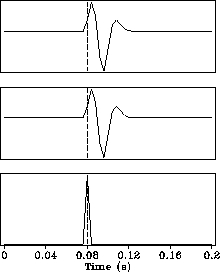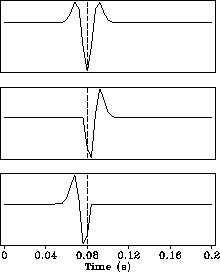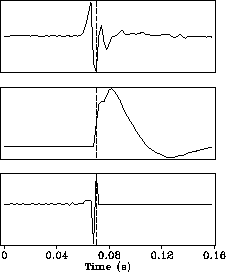The phase spectrum is usually calculated by taking the arctangent of the ratio
of imaginary to real parts of the Fourier transform. Because the arctangent
function is a multivalue function, its principal value has to be determined
as being, for example, between ![]() and
and ![]() . However, the phase spectrum calculated
from the principal-value range is not a continuous function. It does not
satisfy equation (5). One way to solve this problem is to add
appropriate multiples of
. However, the phase spectrum calculated
from the principal-value range is not a continuous function. It does not
satisfy equation (5). One way to solve this problem is to add
appropriate multiples of ![]() to the samples of the principal value.
The appropriate multiple of
to the samples of the principal value.
The appropriate multiple of ![]() can be determined by assuming that
the sampling interval is sufficiently small so that the discontinuities
between adjacent samples of the phase spectrum correspond to
can be determined by assuming that
the sampling interval is sufficiently small so that the discontinuities
between adjacent samples of the phase spectrum correspond to ![]() phase-wrap-around. If the phase spectrum varies rapidly, zero padding
should be done in the time domain to ensure that there is a sufficiently
small sampling interval in frequency.
phase-wrap-around. If the phase spectrum varies rapidly, zero padding
should be done in the time domain to ensure that there is a sufficiently
small sampling interval in frequency.
|
swhfactm
Figure 1 The top panel shows a synthetic, minimum phase wavelet delayed for 80 ms. The middle and bottom panels show the minimum phase and maximum phase parts of this wavelet, respectively. The vertical dashed lines indicate the picking positions. The fat, dashed curve superposed on the curve of the top panel is the signal reconstructed from two factorized parts. |  |
|
swhfactz
Figure 2 The top panel shows a synthetic, zero phase wavelet delayed for 80 ms. The middle and bottom panels show the minimum phase and maximum phase parts of this wavelet, respectively. The vertical dashed lines indicate the picking positions. The fat, dashed curve superposed on the curve of the top panel is the signal reconstructed from two factorized parts. |  |
|
vwhfact
Figure 3 The top panel shows a trace recorded in a marine survey. The middle and bottom panels show the minimum phase and maximum phase parts of this wavelet, respectively. The vertical dashed lines indicate the picking positions. The fat, dashed curve superposed on the curve of the top panel is the signal reconstructed from two factorized parts |  |
Now let us look at some examples. Figure ![[*]](http://sepwww.stanford.edu/latex2html/cross_ref_motif.gif) shows a minimum wavelet
with a delay of 0.08 second. After the spectrum factorization, the minimum
phase part is the original wavelet and the maximum phase part is a spike.
We see that the algorithm picks the first break. Figure
shows a minimum wavelet
with a delay of 0.08 second. After the spectrum factorization, the minimum
phase part is the original wavelet and the maximum phase part is a spike.
We see that the algorithm picks the first break. Figure ![[*]](http://sepwww.stanford.edu/latex2html/cross_ref_motif.gif) shows the results in the case of a zero phase wavelet.
As expected, the central peak of the zero phase wavelet is picked.
In both cases, the correct delays are found.
Figure
shows the results in the case of a zero phase wavelet.
As expected, the central peak of the zero phase wavelet is picked.
In both cases, the correct delays are found.
Figure ![[*]](http://sepwww.stanford.edu/latex2html/cross_ref_motif.gif) shows the picking result of a trace recorded in a
marine survey. The wavelet generated by an air-gun propagates through water
and is recorded by a hydrophone. It is apparent that the picking position is
not the first break. The minimum phase part contains mainly low frequency
components while the maximum phase part contains only high frequency components.
The non-overlapping spectra of two parts indicate that the factorization
algorithm may become numerically unstable. However, the instability
of the spectrum factorization does not affect the results of traveltime
picking because the formula for calculating n0 uses the total phase
response. The spectrum factorization is only used to explain the
principle of picking.
shows the picking result of a trace recorded in a
marine survey. The wavelet generated by an air-gun propagates through water
and is recorded by a hydrophone. It is apparent that the picking position is
not the first break. The minimum phase part contains mainly low frequency
components while the maximum phase part contains only high frequency components.
The non-overlapping spectra of two parts indicate that the factorization
algorithm may become numerically unstable. However, the instability
of the spectrum factorization does not affect the results of traveltime
picking because the formula for calculating n0 uses the total phase
response. The spectrum factorization is only used to explain the
principle of picking.